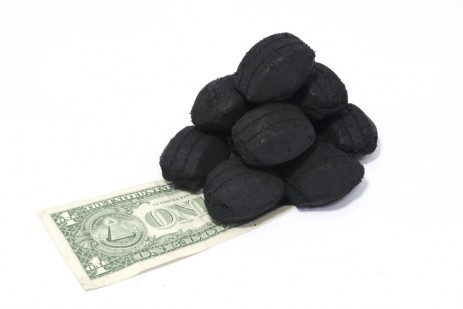
Why are we handing Big Coal our bacon?
The most important thing you can read this week is Joe Smyth’s post on federal coal leasing. I realize “federal coal leasing” is not a phrase to quicken the pulse, but it’s a Very Big Deal.
A couple of weeks ago, I explained the situation the U.S. coal industry is in: domestic electricity use has leveled off, utilities are switching to cheap natural gas and wind, and the EPA is finally cracking down on dirty old coal plants. All that leaves U.S. coal in a pinch. Their main hope for the future is to increase coal exports. That’s why the fight over coal export terminals matters.
Arguably, though, the coal-export fight is secondary. From a climate-hawk point of view, it would be better just to leave the damn coal in the ground.
Is that even within our power as concerned U.S. citizens? As it happens, yes, it is, because we own much of the coal! The coal that companies like Peabody are itching to export comes from the Powder River Basin in Wyoming and Montana. And most of the land in the Powder River Basin is owned by the federal government — that is to say, it’s owned by you and me.
The federal Bureau of Land Management leases the land to coal companies at bargain-basement prices, so they can strip-mine it and export the coal at a profit. Does that sound like good public policy to you?
You really should read Smyth’s whole post for the details, but here’s the important bit:
The BLM’s role is critical because unlike other regions such as Appalachia, Powder River Basin coal is mostly owned by the federal government, and BLM is supposed to ensure that coal development there “is in the best interests of the Nation.” But without proper oversight, the BLM has been offering this federal coal to companies like Peabody, Arch Coal, and Cloud Peak Energy for bargain rates. Over the last 30 years, this has amounted to a $28.9 billion subsidy to the coal mining industry and helped coal maintain its large share of US electricity generation by keeping coal prices artificially low, as explained in a report [PDF] and legal brief [PDF] by Tom Sanzillo of the Institute for Energy Economics and Financial Analysis. These low prices have also helped the Powder River Basin soar from just 5% of US coal production in 1970 to almost half today — even though the Federal Government no longer classifies the region as a coal-producing region. If this sounds absurd, that’s because the BLM’s process for leasing US coal is skewed to benefit coal mining companies, lacks proper oversight and public participation, and is basically corrupt — check out the WildEarth Guardians for more info. [my emphasis]
Speaking of that corrupt BLM process, there’s a lease auction happening today — BLM is selling off the “South Porcupine Tract,” which contains “an estimated 401,830,508 tons of mineable coal.” But the size of this lease is modest relative to the huge expansion of leasing the administration announced last year. When all that newly leased coal is burned, it will contribute 3.9 billion tons of CO2 to the atmosphere, more than half what the U.S. emits in a year. (See also Joe Romm on this.)
As Smyth writes, this travesty is finally starting to get some attention from politicians like Rep. Ed Markey (D-Mass.) and Oregon Gov. John Kitzhaber (D). They are asking why U.S. taxpayers should subsidize coal companies to degrade Western port towns to export coal to Asia where it will accelerate climate change. That makes sense for no one other than the coal companies.
The BLM’s own justification for the lease doesn’t even make sense, as Smyth explains:
Keep in mind that in its Record of Decision [PDF] for [today’s] South Porcupine lease, the BLM justified the decision by asserting that doing so would help “meet the national coal demand,” and that “The public interest is served by leasing the South Porcupine LBA tract because doing so provides a reliable, continuous supply of stable and affordable energy for consumers throughout the country.” At a time when coal’s share of US electricity generation has dropped 19% in one year to just 36%, and Peabody’s CEO is touting plans to profit from “the global coal supercycle,” even the twisted logic of BLM’s coal leasing process falls apart. How exactly is it in the “best interests of the Nation” to sell coal that belongs to US taxpayers at a discount so Peabody can strip mine and ship it to Asia? [my emphasis]
That’s a damn good question.
My question is, where’s the climate movement on this? More than Keystone XL, more than individual coal plants, more even than coal export plans, this seems to be where the real action is. The entire climate fight over coal is an attempt, often by indirect means, to keep the damn coal in the ground. And yet here’s a bunch of coal in the ground that U.S. citizens already own, and it’s being sold by an allegedly climate-concerned administration to coal companies for no particular public benefit. It seems like a place where concerted pressure could have an effect.
Why isn’t this the center of the climate fight right now?




